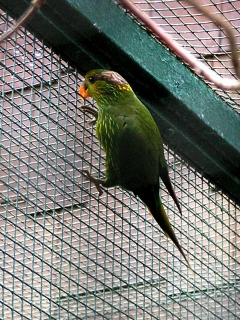Striated Lorikeet |
|
|
Also known as: Streaked Lorikeet, Yellow-streaked Lorikeet
Photos
View in GalleryDid You Know?
This species is possibly nomadic, meaning it moves from place to place, probably in response to food availability.Academic Research
Related publications: Charmosyna multistriataSpecies Profile
Genus: Charmosyna | Species: multistriata
Size:
18 cm (7 in)
Weight:
40g (1.4 oz)
Subspecies including nominate:
one
Colour Adult:
Both adults brown hindcrown and nape, with orange/yellow spotting which varies between individuals; dark green breast streaked with yellow/green, the remainder of underparts green streaked with green/yellow; red vent; olive/green tail tipped with dusky yellow, with red bases of lateral feathers. Bill orange with grey at base. Eye red.
Colour Juvenile:
As in adults but orange/yellow spotting on nape duller and smaller.
Call:
Calls are distinctive, with mostly single drawn-out whistles, sometimes becoming two or three notes; some chattering before beginning of whistling calls.
Video Links:
Video 1More Information:
Content Sources:
CITES
BirdLife International
Cornell Lab of Ornithology/Birds of the World
A Guide to Parrots of the World, Juniper and Parr, 1998
Parrots of the World, Forshaw, 2006. 2010 edition
Parrots in Aviculture, Low, 1992.
Lexicon of Parrots, Thomas Arndt.
Parrots: Their Care and Breeding, Low, 1986.
Photos
View in GalleryDid You Know?
This species is possibly nomadic, meaning it moves from place to place, probably in response to food availability.Academic Research
Related publications: Charmosyna multistriataSpecies Care
Captive Status:
Rare
Longevity:
Not recorded.
Housing:
Aviary or enclosure with well-drained, tiled or concrete floor, or suspended cage over same.
Diet:
Nectar, either a commercial type formulated for small species or one homemade from lactose free baby cereal, honey, malt extract or molasses, mixed with filtered water and made fresh once or twice daily; fruits such as: apple, pear, peaches, bananas and cactus fruits.
Enrichment:
Provide unsprayed flowering branches. Provide overhead misters or shallow water bowls for bathing.
Nest Box Size:
Vertical box 12cm x 12cm x 25cm (5 x 5 x 10 in).
Clutch Size:
2
Incubation Time:
25 days
Fledging Age:
7 1/2 weeks
Hatch Weight:
Not recorded.
Peak Weight:
Not recorded.
Weaning Weight:
33g (1.1 oz)
Photos
View in GalleryDid You Know?
This species is possibly nomadic, meaning it moves from place to place, probably in response to food availability.Academic Research
Related publications: Charmosyna multistriataSpecies Wild Status
World Population:
Unknown, decreasing.
IUCN Red List Status:
Near Threatened
CITES Listing:
Appendix II
Threat Summary:
A BirdLife “restricted-range” species. Little known and poorly recorded but is threatened by logging and clearance for agriculture.
Range:
Southern slopes of main range in W New Guinea, from Snow Mountains, Irian Jaya, east to Crater Mountain, Papua New Guinea.
Habitat:
Found between 180-1800m (590-5904 ft) in montane and hilly forest and forest edges.
Wild Diet:
Feeds on flowers of canopy trees and epiphytes, including Dimorphanthera and Poikilospermum.
Ecology and Behaviour:
Seen in pairs or small groups of up to 20 birds. Has been seen in groups with Red-flanked and Fairy Lorikeets. Stays to the tops of flowering trees in the canopy.
Clutch and Egg Size:
2 eggs, 16.4 x 19.7mm (0.6 x 0.7 in).
Breeding Season:
Not recorded.
Photos
View in GalleryDid You Know?
This species is possibly nomadic, meaning it moves from place to place, probably in response to food availability.Academic Research
Related publications: Charmosyna multistriataMembers Only Resources
Please log-in now to find more research, resources and tools.
Not a Member?
Find more great information:
Gain exclusive access to 600+ pages of additional research, seminars and podcasts, specialists to ask your toughest questions, and dozens of other fun resources - when you become a WPT member.
Join Today >>

































